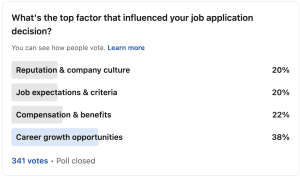Optimise recruitment process: 10 proven strategies for efficient recruiting
In today’s business world, the recruitment process in companies often forms the basis of their long-term success. And that is why today we will tell you how to optimise your company’s recruitment process here.
Table of contents
With increasing competition and a constantly changing world of work, it’s essential always to attract the best talent. A targeted and efficient running of recruitment processes plays a central role here. Since recruitment often involves significant costs and time, optimising the recruitment process should be at the top of the company’s agenda.
To help companies overcome this challenge, we’ve put together 10 proven strategies to optimise recruitment processes and attract the best talent to your team.
Why is the recruitment process so critical
A recruitment process is not only the method for recruiting personnel, but also a key instrument for long-term company success. Here are a few reasons why:
- Competitive advantage: In a dynamic market, the right talents offer innovation and professional know-how that make a company stand out from the competition.
- Company culture: An effective recruitment process ensures that new employees fit into the existing company culture, which positively influences the working atmosphere.
- Cost efficiency: Optimised recruitment minimises costs caused by long vacancies or incorrect hiring.
- Employee retention: A transparent and well-thought-out recruiting process promotes a sense of appreciation and strengthens employee retention.
- Adaptability: Companies that navigate the talent market adapt to change faster.
The 7 stages of recruitment
Before you dedicate yourself to optimising your recruitment process, it’s crucial that you develop an in-depth understanding of its structure and flow. That’s why we’ll start by walking you through the 7 recruitment stages below.
Efficient and successful recruiting involves much more than just posting job ads. It’s a multifaceted process that extends over various phases.
A better understanding of these phases can help companies take the right recruiting measures, use the right recruiting channels, and ultimately make the best hiring decisions. Here is a detailed look at each of the individual phases:
- Needs analysis: Everything starts with identifying the need for personnel. This may include not only vacancies due to layoffs, but also new positions arising due to company growth or strategic realignments.
- Creation of the requirements profile: As soon as a need has been identified, a detailed requirement profile must be created. Such a profile must describe the qualifications (hard skills), experience, and soft skills that a suitable applicant should have.
- Job advertisement: With the requirement profile defined, a job advertisement can be formulated and published. Choosing the right platforms — be it free job boards, social media or trade magazines — is crucial for the reach of the ad.
- Applicant selection: Once applications have been received, they are viewed and filtered. After initial applican screening, the most suitable candidates are selected based on the requirements profile and invited to an interview.
- Interviews: Recruiters and applicants get to know each other in multiple interviews. During this phase, not only will the necessary qualifications be checked, but it will also be determined whether the applicants fit the company culture.
- Decision-making and offer: After the interviews are over, impressions and results are assessed, and a final decision is made. Selected applicants will be offered an employment contract.
- Onboarding: As soon as a candidate accepts the position, the onboarding process into the company begins. This should be well structured to give new employees a smooth start and strengthen their loyalty.
A deeper understanding of these phases not only makes it easier to optimize a recruiting process, but also increases the probability of attracting the right employees for your company in the long term.
10 proven strategies for optimising recruitment processes
1. A clear definition of the requirements profile:
The first and most decisive step of any successful recruiting process is a clear definition of the employee profile that you are looking for. It serves as a compass through the entire search and selection process.
In addition to technical qualifications and specialist knowledge, personality traits, behaviour and cultural fit with the company are also very important. It is crucial to find a balance between these aspects. The easiest way to create a precise requirements profile is to prepare it together with future team members and managers.
Recommended reading: The cultural fit controversy (and how to hire better)
You can outline a comprehensive picture of the ideal candidate together through brainstorming and discussions. This not only ensures an accurate job posting but also reduces the effort involved in candidate selection and minimises the risk of hiring the wrong person.
2. The use of cutting-edge technology:
Advancing digitalisation has profoundly changed the traditional recruiting process and offers opportunities that were unthinkable just a few years ago. AI-based tools can be used to help you to review applications quickly and precisely and identify the best possible candidates. CV parsing, for example, can be of great help here.
Applicant tracking systems are able to structure and organise the entire process, from tendering to recruitment. Online interview platforms enable flexible and location-independent conversations, which is particularly advantageous in the current globalised world of work.
JOIN, for example, was recently recognized by Capterra as the most user-friendly software solution. We are always working to update our software to meet the latest trends and requirements in the recruitment process, to be able to offer the most comprehensive recruiting solution to you. Thank you for your positive reviews!
3. Improving communication:
Open and clear recruitment communication is the foundation of a smooth recruitment process. When HR teams, managers, and applicants are on the same page and interact with each other on a regular basis, the entire process becomes more transparent and effective.
This not only promotes candidates’ trust, which can be decisive for their loyalty to the company but also helps identify and clarify potential misunderstandings or ambiguities at an early stage, preventing delays.
The easiest way to implement such communication is by using an applicant tracking system — such as JOIN’s free recruitment software.
You can use it to communicate with your team members in the candidate pipeline, send messages to your candidates using the messages feature, or even automate messages so that everyone involved is always up to date and aware of the current status of the recruitment process.
4. Offering further training opportunities:
At a time when lifelong learning is becoming more and more important, talented people are specifically looking for companies that are willing to support them in their professional development.
By offering further training opportunities (upskilling), companies demonstrate their willingness to invest in their employees’ expertise and their recognition and appreciation for their individual career goals. This is a crucial factor in attracting the best talent and its long-term retention.
This is also clear from one of our surveys on LinkedIn, in which most respondents said professional development opportunities when asked which factor most influenced their decision to apply.
An annual training budget or access to educational institutions or online course platforms are the easiest way to provide your employees with specialised learning programs. It can also be effective to organise internal workshops, training courses, or mentoring programs to optimally use and pass on the existing knowledge in the company.

5. Diversifying existing search strategies:
When looking for the best talent, companies should not rely exclusively on traditional methods. In addition to choosing the right job boards or niche job boards, it is advised also to attract candidates by sourcing passive candidates.
While job portals are an excellent point of contact, there are many qualified candidates who can be reached via other channels. Social media such as LinkedIn or XING, specialist forums and specialised networking events can often provide undiscovered talent. The key here is to adapt your strategy to a specific target group.
6. Using employee referral programs:
Who could communicate a company’s culture, values, and benefits better than those who are already a part of it? In fact, your own employees are often the most authentic and convincing ambassadors here.
By implementing an Employee Referral Program (ERP), companies can often benefit from their internal network. Such a program motivates employees to recommend qualified acquaintances, friends, or former colleagues for open positions in their companies.
In addition to increasing the hiring rate, such a program often ensures that applicants are better suited to the corporate culture, as employees usually recommend people who they believe would be a good fit for the team.
7. Introducing a feedback process:
An open dialogue with applicants and team members can make a huge difference when it comes to optimising a recruitment process. Candidates can provide insights into the process, communication, and overall experience.
Recommended reading: 10 efficient feedback models for your workplace
Likewise, internal stakeholders, such as HR employees and department managers, can share valuable information about the selection process, the quality of candidates and other relevant aspects. By gathering these perspectives, companies can specifically identify areas of improvement.
8. Maintaining speed:
An agile and up-to-date approach to your recruitment process is crucial in today’s fast-paced business world. Candidates, particularly highly qualified candidates, often consider several offers at the same time.
Protracted decision-making can result in a company losing valuable talent to its competition. Recruitment process should, therefore, be structured and efficient without sacrificing care.
To ensure proper speed, you can take the following measures:
- Recruitment automation
- Clear communication channels
- Flexible interview options
- Preparation of interviews
9. Boosting your brand’s presence:
In the modern business world, employer branding plays a central role. It not only acts as a magnet for talented applicants but also strengthens the loyalty of current employees to the company.
This can be done by communicating the company’s culture, values, and mission to show your employees what makes their company special.
To intensify such presence, companies can share stories via social media, use employees as brand ambassadors, as well as be active on platforms such as Kununu or Glassdoor. Positive feedback highlights the company profile, while constructive reviews highlight opportunities for further development.
10. Regular reviews of your recruitment process:
In the dynamic world of recruiting, standing still can actually be a step backwards. It is, therefore, crucial to continuously review and update your recruitment process.
An annual review, for example, in the form of a workshop or an internal audit session, can help identify bottlenecks and adapt best practices. Here, companies can use modern tools and analysis software to evaluate data from the past year as well as to identify new trends.
This approach not only ensures that companies are always up to date when it comes to recruiting but also enables an agile response to recruitment trends and the changing requirements of applicants.
An efficient recruitment process is worth its weight in gold
In the modern business world, talent is the most valuable asset. That’s why the often underestimated recruiting process is much more than just an operational task — it’s the core of strategic personnel planning.
It is not just about filling vacancies but about laying the foundations for future success and innovation.
By implementing and continually optimising a well-thought-out recruitment process, companies not only position themselves as attractive employers on the market, but also create internal synergies. This reduces cost per hire, shortens time to hire, and improves quality of hire.
For a full list of points to track, see our article on the top recruitment KPIs!
The right mix of strategy, technology, and humanity in the recruiting process not only promises short-term success, but also lays the foundation for long-term corporate visions. Because in reality, it is people, their skills, their passion and their innovations that drive companies forward and create competitive advantages.
In this respect, an efficient recruitment process is not only worth its weight in gold — it is the life giver of future-oriented organisations.
You can find more articles with tips and tricks on how to look for employees on our Recruiting and HR blog.
Mia Worts
Mia Worts is a Junior Content Marketing Manager at JOIN. Finding solutions for companies to increase their employee retention in a sustainable way is one of her favorite topics to write about. Not only does she care about the future of work but also about creating a sustainable life aside from the job world by cooking animal-free foods and choosing sustainable alternatives.



![Hiring a project manager [how-to guide]](https://cdn-public-assets.join.com/2023/10/8d26d04c-hiring-project-manager.jpg)
